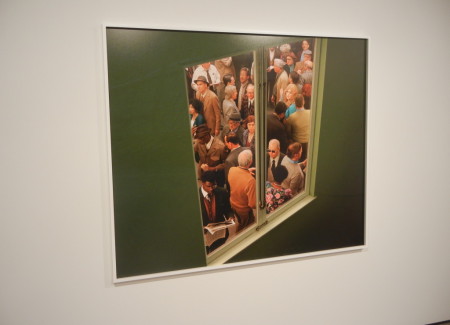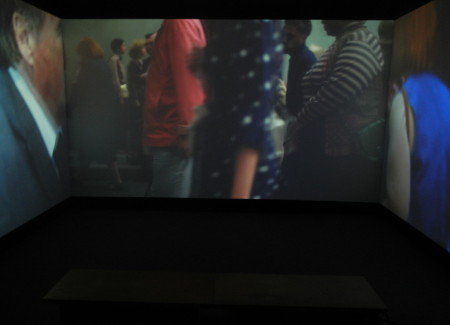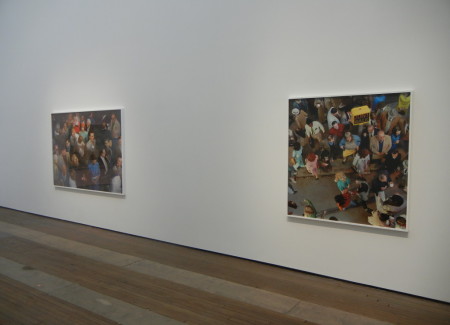JTF (just the facts): A total of 16 large scale color photographs, framed in white and unmatted, and hung against white walls in the main room of the West 26th Street location and in the main room and the entry area of the Chrystie Street space. All of the works are archival pigment prints, made in 2013. 6 of the works are four image vertical arrays (like film strips), while the other 10 are single images. The film strips are sized 48×23 while the single images range in size from 60×56 to 60×92; all of the images are available in editions of 6. A three channel video from 2013 entitled Face in the Crowd runs in a darkened room in the back of the West 26th Street location. (Installation shots of both locations below.)
Comments/Context: Alex Prager is one of the hottest names in contemporary photography, and following up on the success of her most recent show in 2012, she has taken to heart the “go big or go home” mantra that now pervades the art world. While she continues to explore both film and photography, her artistic ambitions have grown – her newest project is more complex, with much bigger stage sets and more elaborate and numerous actors, now delivered in larger prints, a two venue New York gallery show, and a concurrent museum exhibit at the Corcoran. This is Alex Prager expanded and super-sized, amplified for wider effect.
Prager’s newest work centers on the unfortunately vapid observation that crowds aren’t just faceless mobs, but are instead made up of groups of discrete individuals. As insights go, this one isn’t particularly original, but she artistically mines this theme for all it’s worth. In roughly a dozen separate scenes, she takes a bird’s eye view of crowds and clusters of people: at the beach, in the stands at a stadium, in the airport waiting area, on a street corner, at a cocktail party, or in formal wear at the theater. Every scene is a small movie of its own, with dozens of actors and extras, each in a specific costume and makeup, jammed together in a tight space. What’s different about Prager’s crowds, from those of Weegee at Coney Island or any of a number of photojournalists capturing political rallies or protests, is that the crowd doesn’t dissolve into a sea of anonymous faces but instead stays crisp and detailed from edge to edge across all distances, giving the images a sense of hyper reality that can be explored at any resolution. Amid all the chaos of bodies, any single individual can be picked out and seen clearly, his or her period costume fully visible, along with facial expressions, gestures, and looks that bounce around the frame. There are dozens of stories in each picture just waiting to be discovered.
These public crowd scenes are then stitched together into a larger narrative arc in Prager’s short film. Smartly installed in a tight space that increases the work’s enveloping claustrophobia, the three screen film follows the mixed emotions of the lead character (played by Elizabeth Banks), who is initially drawn to the bustling joy of the crowds, but then starts to feel trapped and anxious as the jostling thickness closes in. This progression is interspersed with talking head confessionals by various individuals, bringing single peripheral characters into focus for just a moment. We’ve seen this kind of snippet storytelling before, but Prager ultimately brings her signature sense of melodrama to the forefront and the crowds become a cackling, ominous assault.
This new Alex Prager, fortified and expanded from her original artistic roots, offers plenty of moments of visual seduction; as a viewer, I was more than once pulled into her single frame scenes, wandering from face to face marveling at the subtle comedy of her stylized alone-in-a-crowd characters. And while I have no doubt that these large tableaux will be well received, I came away from the paired shows wishing that the emotional terrain in the single images was deeper and more intense. What has always drawn me to Prager’s work is that sense of desperation and vulnerable despair that simmers underneath her characters, even when it is exaggerated for Hitchcockian effect. These pictures still have Prager’s essence, but their personal vitality has somehow been diluted when multiplied out so many times. I came away impressed by the Where’s Waldo all-overness of her compositions and the immensity of the technical logistics of such large projects, but that enthusiasm was tempered by a lingering feeling of overdone emptiness. Perhaps that centerless disconnection was the whole point, and I just need to let them grow on me a bit.
Collector’s POV: The prints in this show range in price from $15000 to $40000 based on size, a major increase from her last show at Yancey Richardson in 2012 (she has since changed representation to Lehmann Maupin). Prager’s work has also become more visible the secondary markets in the past few years, with prices ranging from roughly $5000 to $63000.














There’s a lot to like here but something about it resonates with remarks I read yesterday by Magnum nominee Bieke Depoorter:
“In the past I was more of a street photographer, but then I felt bad about stealing something from someone I didn’t know.”
http://ideastap.com/ideasmag/the-knowledge/bieke-depoorter-Magnum-photographer
I’m wondering if we’ve not really moved on all that much since the seventies. Back then anti-photography art intellectuals were particualarly hostile to street photography. And back then Jeff Wall wisely responded to the situation with his gallery-friendly, ‘ethically acceptable’ staged street scenes. It has to be said his emergence was to benefit photography generally. There are a ton of other issues here about which kinds of photography are more valued in the art world than others and why that is the case, but as for those old school morality lessons that were being disseminated a generation ago they seem to be alive and well and still playing a part in how we regard images.
This show isn’t working. Especially when you look at other crowd images by fine artists. San Douglas’ images for crowds are similar in viewpoint but executed by a fully developed artist. In Prager’s case there are many far better artists to collect who’s prices haven’t been so very blown out of proportion to the talent.
There is a direct correlation between the number of characters in a tableau and its believability. I’ll take a Massimo Vitaly or Gursky actual crowd in an actual space over these cheesy sets any day. Just because one now has the money to do something, doesn’t mean one should.